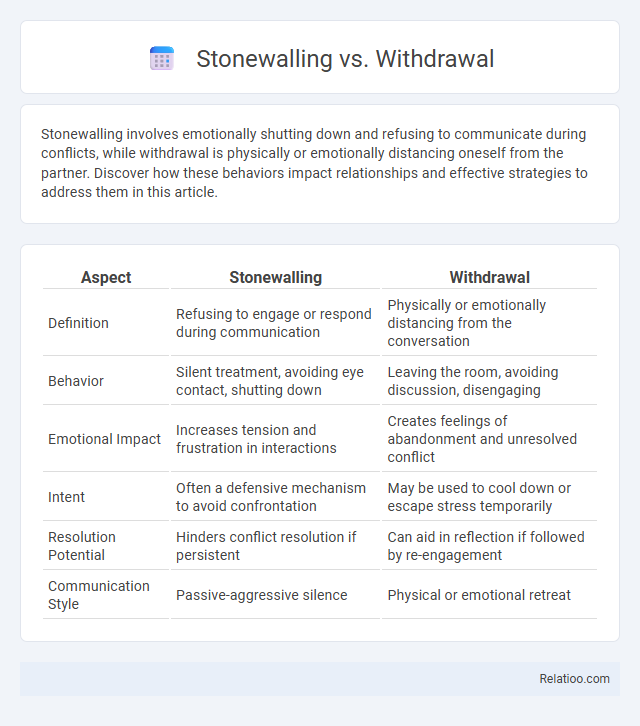Stonewalling involves emotionally shutting down and refusing to communicate during conflicts, while withdrawal is physically or emotionally distancing oneself from the partner. Discover how these behaviors impact relationships and effective strategies to address them in this article.
Table of Comparison
| Aspect | Stonewalling | Withdrawal |
|---|---|---|
| Definition | Refusing to engage or respond during communication | Physically or emotionally distancing from the conversation |
| Behavior | Silent treatment, avoiding eye contact, shutting down | Leaving the room, avoiding discussion, disengaging |
| Emotional Impact | Increases tension and frustration in interactions | Creates feelings of abandonment and unresolved conflict |
| Intent | Often a defensive mechanism to avoid confrontation | May be used to cool down or escape stress temporarily |
| Resolution Potential | Hinders conflict resolution if persistent | Can aid in reflection if followed by re-engagement |
| Communication Style | Passive-aggressive silence | Physical or emotional retreat |
Understanding Stonewalling and Withdrawal
Stonewalling involves refusing to communicate or engage in a conversation, often as a defense mechanism to avoid conflict or emotional discomfort. Withdrawal refers to physically or emotionally distancing oneself from a situation or relationship to gain space or reduce stress. Understanding the nuances between stonewalling and withdrawal is critical for improving communication and resolving conflicts effectively in relationships.
Key Differences Between Stonewalling and Withdrawal
Stonewalling involves actively blocking communication and refusing to engage, characterized by silence, evasiveness, or dismissive behavior, while withdrawal refers to emotionally or physically retreating from interaction without overt resistance. Key differences include stonewalling's confrontational stance designed to shut down dialogue, whereas withdrawal is more passive and may signal avoidance or self-protection. Understanding these distinctions is crucial in relationship counseling to address underlying issues of communication breakdown effectively.
Psychological Roots of Stonewalling
Stonewalling, characterized by emotional shutdown or refusal to engage, often stems from deep psychological roots such as fear of conflict, vulnerability, or past trauma. Withdrawal involves physically or emotionally distancing oneself to avoid confrontation, which differs from stonewalling's active resistance to communication. Understanding these patterns helps you address underlying emotional issues and improve relational dynamics effectively.
Why People Resort to Withdrawal
People resort to withdrawal as a defense mechanism to avoid conflict, stress, or emotional overwhelm during intense conversations. This behavior often stems from fear of vulnerability, desire for self-protection, or past experiences of invalidation and rejection. Withdrawal creates distance to regain emotional balance but can hinder effective communication and relationship resolution.
Behavioral Signs: Stonewalling vs Withdrawal
Stonewalling behavior is characterized by a complete refusal to engage in communication, often manifesting as silence, avoiding eye contact, and turning away during conflicts. Withdrawal involves a more passive retreat from interaction, such as physical distancing, minimal responses, or emotional detachment without outright refusal to communicate. Recognizing these behavioral signs helps you address relationship challenges by identifying whether your partner is stonewalling to shut down communication or withdrawing as a coping mechanism.
Emotional Impact on Relationships
Stonewalling causes emotional distance and frustration by shutting down communication, making Your partner feel ignored and undervalued in the relationship. Withdrawal, which involves physically or emotionally pulling away, often leads to feelings of loneliness and abandonment, weakening emotional intimacy. Both behaviors negatively impact trust and connection, ultimately eroding the foundation of a healthy partnership.
Communication Patterns: Comparing Both Behaviors
Stonewalling and withdrawal are distinct communication patterns often observed in conflict situations, where stonewalling involves refusing to engage or respond, creating emotional distance, while withdrawal typically means physically or emotionally pulling away to avoid confrontation. Both behaviors disrupt effective communication by blocking dialogue and preventing resolution, but stonewalling is more passive-aggressive, and withdrawal can be a coping mechanism. Understanding these dynamics helps you recognize harmful patterns and encourages healthier, more open interactions.
Overcoming Stonewalling in Relationships
Stonewalling is characterized by emotional shutdown and refusal to engage during conflicts, often leading to withdrawal and escalating relationship tension. Withdrawal involves physically or emotionally pulling away, which can intensify feelings of isolation and miscommunication between partners. To overcome stonewalling in your relationship, practice open communication, maintain emotional regulation, and seek couples therapy if persistent patterns prevent productive dialogue.
Strategies to Address Withdrawal
Withdrawal in relationships often involves emotional disengagement as a defense mechanism, distinct from stonewalling, which is characterized by refusal to communicate or cooperate. Strategies to address withdrawal include fostering open emotional expression, encouraging vulnerability, and creating a safe space for dialogue to rebuild trust. Therapeutic approaches like Emotionally Focused Therapy (EFT) emphasize recognizing withdrawal patterns and developing constructive communication skills to restore connection.
Seeking Professional Help: When to Intervene
Recognizing the differences between stonewalling and withdrawal is crucial for seeking professional help, as stonewalling involves emotional shutdown and refusal to communicate, while withdrawal may indicate temporary disengagement due to stress. Early intervention by therapists can address these patterns before they escalate into chronic relationship issues or emotional distress. Professional support is recommended when communication breakdown leads to persistent conflict, emotional disconnection, or mental health concerns.

Infographic: Stonewalling vs Withdrawal
 relatioo.com
relatioo.com